Against The Storm
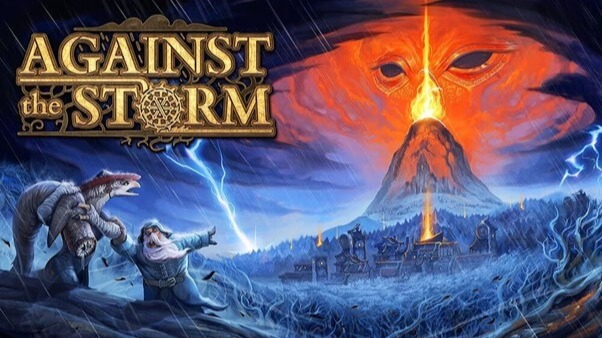
Against The Storm - A bizarre mix of genres
City-building strategies are always an extremely niche product. So niche that players unfamiliar with the genre sometimes find it impossible to understand the differences between the games. But one thing remains unchanged: urban strategies captivate the minds of a handful of players, while the vast majority are intimidated by the piles of interconnected mechanics and scrupulous resource management. But every rule has exceptions...
...And if there's a city-building strategy that can be mastered without a guide, its name is Against The Storm. But what does rogue-lite have to do with it?
How did the concept of Roguelike get along with strategy...
The goal of any strategy is to gain critical mass in a planned manner. In real-time strategies with an emphasis on the combat system it is important to balance the development of the city and the army. In city-building strategies, it is critical to establish production and manage the mood of the population. There are also strategies with indirect control, where the player sets tasks for his subjects, but can not move the units themselves. Indirectly controlled strategies require the player to be consistent, but do not require filigree micro-control. But none of these options do not have the attributes of rogue-lite. The basic mechanics of any Roguelike, - permanent death, chops at the root of the ultimate strategy goal - to build a city, win a battle, outpace the enemy technologically... Or not?
The developers from Eremite Games think otherwise. In Against The Storm, typical roguelike races are story-driven. Against The Storm tells the story of a fantasy world. At the center of this world is the Smoldering City, which has been ruled by the Scorched Queen for centuries. Every 20 years Storm descends upon the world, wiping out all nearby cities but leaving the capital untouched. The Smoldering City is the only place untouched by the Blizzard, the capital protected by the Queen's sorcery. It is a world of unrelenting centralization. The only way to survive is to earn the favor of the Queen. For favor flares up a serious competition between the clans. After all, the only way to survive is a place in the Scorched City. In this story, the player is assigned the role of viceroy, who must, by all means, to arrange for the welfare of the city and the production of resources. The root mechanic of Roguelike is played here through service. There are two scales: one for the Queen's favor and one for her impatience.

Favor is earned through skillful management of the city, donations, meeting the needs of a whimsical population, and obeying edicts. The queen is constantly capricious and gives out errands. The subordinate governor, on the other hand, is obliged to fulfill these whims. As a reward for faithful service, the player receives resources, blueprints for new buildings and new laborers.
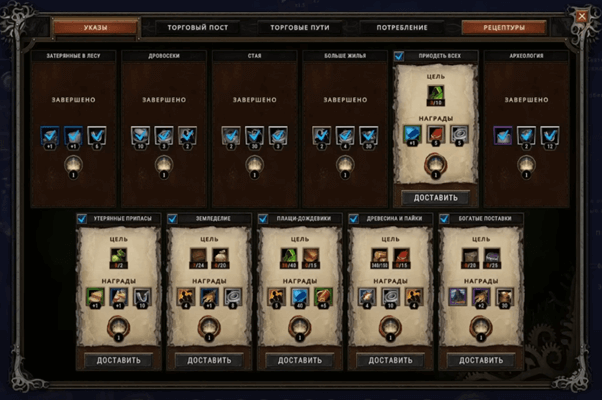
But if you disobey, you can forget about the rights of the viceroy. He will be stripped of all his shoulder straps, throw a piece of bread at him for his efforts, and pass the baton to a more obedient goon. The phrase "throw a piece of bread at him" should be taken literally, because after the unsuccessful run the player will really have to be satisfied with sweet bread. Becoming an exile is not a threat to the viceroy, but, as is the case with other rogue-lites, inept play leads to a halt in-game progress. And that sweet bread is the local currency of meta-progression.

That is, even after playing it terribly, the run will not be useless. Throw the population to certain death and you get food; put the city in order and you get more food. Each icon in the screenshot above is a typical improvement for any rogue-lite a la "+2% to wood mining" or "Morale of population drops 3% less". But as with any rogue-lite, these seemingly useless improvements make each subsequent run a little easier.
Instead of floors and stages, Against The Storm has a global map. Instead of mopping up rooms, it's building a settlement. Instead of elite enemies and bosses, there are 26 difficulty levels. Instead of builds, it's the mechanics of hostile forests, but more on that later...
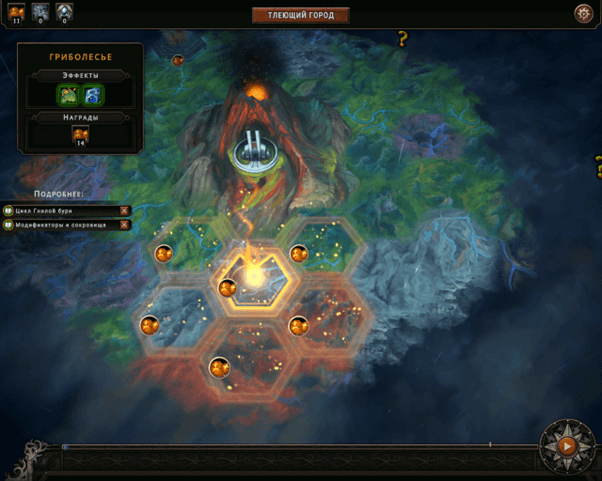
Instead of the mechanics of poisoning, bleeding, stunning and other mandatory RPG attributes, Against The Storm is full of modifiers. Modifiers are similar to curses from Curse of the Dead Gods: often modifiers have both positive and negative sides.
Вместо классического выбора из трёх предметов из сундуков в Against The Storm выпадают чертежи зданий. Разумеется, и чертежи оказываются более или менее полезны в зависимости от ситуации.
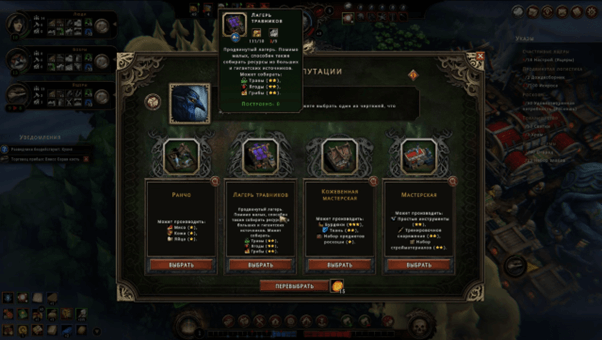
And even the typical Rogue-lite random events have not been spared. In the fog of war there can be treasure, monsters, and abandoned, useful buildings.
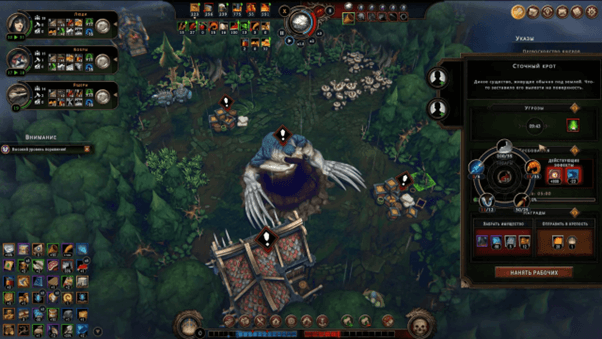
It is hard to say what the game has more: strategy or rogue-lite. But the fact is clear: all the attributes of Rogue-lite carefully preserved and adapted to the strategy genre not typical of it.
Eremite Games has managed to bring to their strategy and diseases of the rogue-lite genre, namely the unplayability of many approaches, many hours of grind currency and monotony. Let's say more, it is unlikely to start and immediately click parties like sunflower seeds. Even though every party develops differently, there is one correct initial algorithm of actions. Non-standard approaches and experimental builds are not about Against The Storm. For example: the lumberjack should be placed only near the fog of war, and some Queen's edicts are clearly better than others.
The second inherent problem of rogue-lite is grind. And it's here, too. Yes, there are different biomes on the global map, they all make adjustments to the gameplay, add variety, but the main motivation to bring the city to mind - it's resources and only. Objectives at the beginning, in the middle and at the end of the game do not differ, only the reward is different. But the more you build up Smoldering City, the more expensive the next improvements will be, so all in-game progress here is illusory. But the player eventually learns to set up production lines, makes no mistakes and wins - just like in any other rogue-lite.
...As a genre of urban strategy live in Roguelike
As for the city-building strategy game Against The Storm, it turned out to be ambiguous. One thing you can't take away from the game - Against The Storm has really low entry threshold, even a newcomer will be able to join it. On the other hand, spoiled fans of urban strategies may not have enough depth: the trade does not take into account the inflation of currencies, and the citizens have few specialties.
The concept of the games is simple: in the center of the location stands the Eternal Flame. It feeds the settlement with hope. It is necessary to toss fuel into the fire from time to time, otherwise the fire will go out, the inhabitants will be discouraged, or even flee into the woods. Eternal fire forms a zone of influence around itself, in which dwellings and industrial buildings function. It would be a mistake to build factories and houses nearby, so it is better to define the working areas and the areas for living at once.
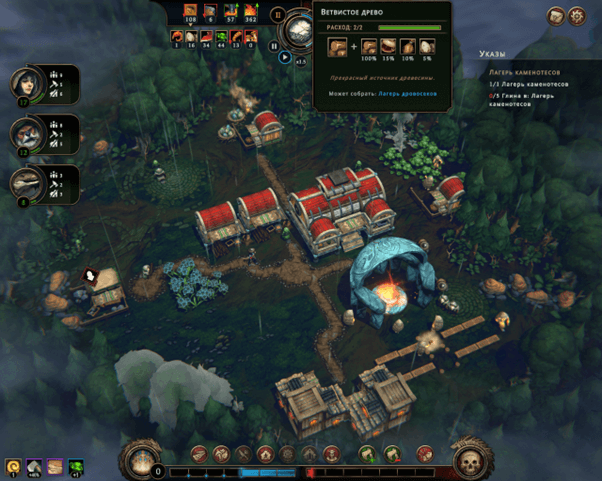
There are many resources, many of which are interchangeable and have several levels. For example, wood becomes boards, boards become buildings; fiber becomes clothing. List all the synergy is difficult, and there is no point. Fortunately, the game has a notebook that lists all the possible combinations. There are specific resources whose purpose is not obvious, but each of the resources is needed for something.
Even if a player is a bad manager at the beginning of the game, he can pause, think, and pull the game out. There are very few stalemate-free situations, and it is possible to lose only through inattention or ignorance.
Role-playing games have classes, and Against The Storm has races: beavers, lizards, and humans. The differences between them are not only in icons and appearance, but also in character. The player will have to do a lot of agonizing before he learns the character of each. The settlers are fastidious. Each individual race likes to eat certain foods, live in certain houses and visit certain places. It's not the case that Humans are good at construction, dwarves love mines, and lizards are skilled with weapons. Every race has a favorite job, and a vocation job. For example, humans are good farmers, but they love brewing. If you force people to plow the field tirelessly, their spirit will diminish. There's a whole list of things that one race or another likes, and it's impossible to please everyone. Keeping the spirit of the townspeople is the hardest thing in Against The Storm, because you can't improve the situation in the state through repression.

The townspeople are not only infantile, but also very superstitious. To rebuild the city, you have to cut down the forest. Like the Zone in S.T.A.L.K.E.R., the Forest in Against The Storm supposedly has its own character and worldview. The forest doesn't want creatures cowering in it, so every now and then it scares the townspeople with fables and curses. For some reason, the townspeople believe in all the tall tales, although no one has ever seen proof of the paranormal. The balance between profit and risk in Against The Storm is built about the same way as it was in Loop Hero: the farther you go, the more chances to lose, but the better the reward.
Is Against The Storm worth buying?
Against The Storm is a good rogue-lite and a good city-building strategy game. The genres don't conflict with each other, which adds up to a fresh gameplay experience. This game has a lot of synergy and a lot of mechanics. But they do not dump all the information on the player's head, there is time to adapt. Unfortunately, it is difficult to understand the game and win by leaps and bounds, but still much easier than in the vast majority of city-building strategies.
The price tag of Against The Storm is quite democratic - about $5. For a game with such a quality, with regular updates for dozens of hours of gameplay the price is more than worthy. On the other side of the scale is the eternal grind and insufficient playthrough variation.
